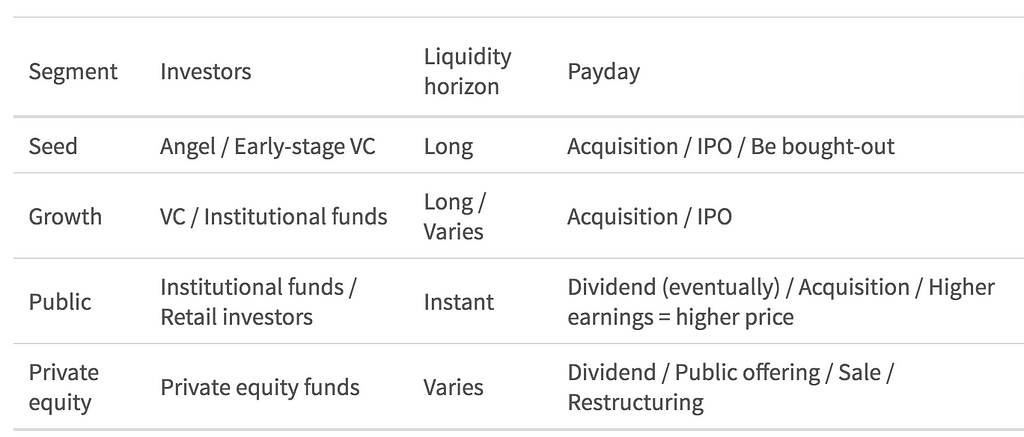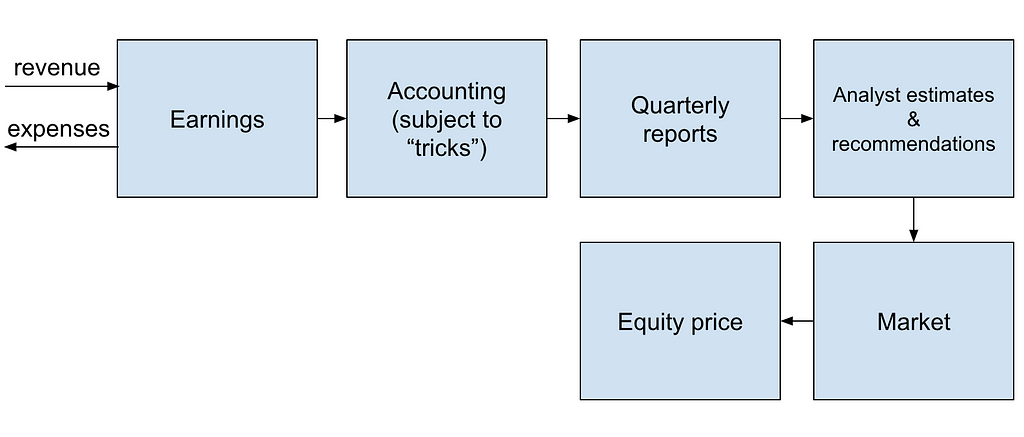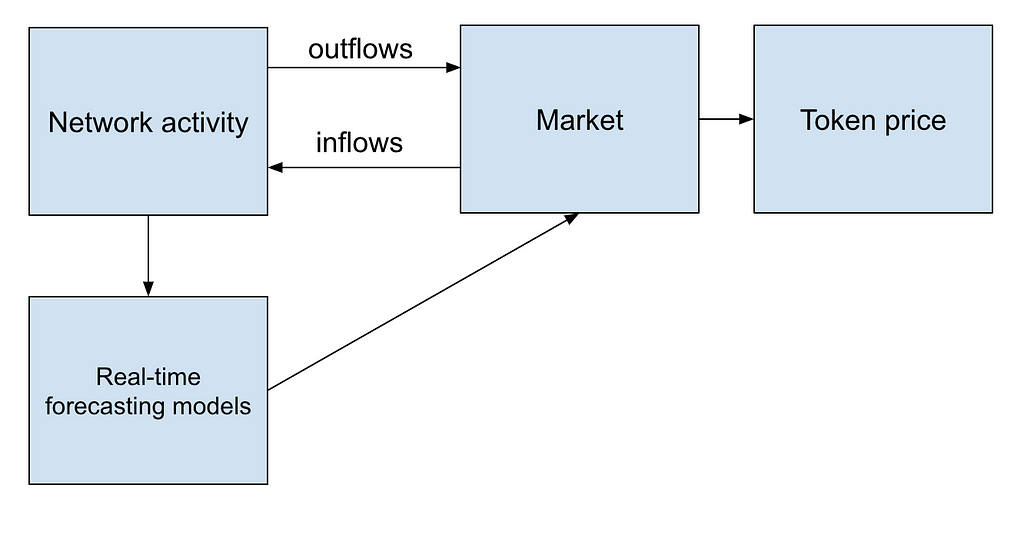Latest news about Bitcoin and all cryptocurrencies. Your daily crypto news habit.
The concept of pooling public capital to fund ambitious projects is not new. Back in the 17th century, the Dutch stock market was already quite developed. Utility tokens, on the other hand, are a totally new and untested phenomenon. The purpose of this article is to compare equity shares and utility tokens, and to explore what their future may look like.
Does equity represent tokenization through bureaucracy, while utility token is an attempt to capture value closer to where it’s created? Let’s start with a quick high-level examination of how the equity market works.
Equities
From an economic standpoint, equity ownership entitles one to a share of future profits and a payout if the company gets bought, plus voting. As such, equity can be valued and sold to bring in cash to finance a project. In other words, the future value can be “captured” and sold to investors.
A distinct property of equity as a tradable asset is the fact that its price tends to be a function of a company’s expected profits, as well as the value of the items on the balance sheet. We’ll examine how this process works shortly.
The equity market can be loosely described as a pipeline, with distinct segments based on the maturity of the business and whether there is a public market for the company’s equity.
Let’s focus for a moment on public equities. Usually if a company is doing great, its stock price goes up, and vice versa. Let’s examine how this link works.
The most common technique used to value financial instruments, including equities, is discounted cash flow (DCF) analysis. As a claim on the future earnings, equity value is the net present value of all future earnings.¹ If one can project the revenue and expenses to estimate earnings for each quarter in the future, they can discount the earnings back to today to arrive at the “fair” company’s market cap.²
Every quarter, companies issue an earnings report accompanied by a conference call with a presentation and a Q-and-A session. There’s a constant race for analysts to update their models to reflect all the available information. They plug in the latest reported numbers and projections into the models. The models spit out new target prices causing traders to adjust their positions accordingly, moving the market until a new equilibrium price is reached. This process ensures that over a long term, equity price tracks the company’s business performance allowing investors to capture the upside.
I believe it is fair to call this process a tokenization through bureaucracy. The future company’s earnings are tokenized and the value of the token (i.e. the share) is linked back to the business performance by virtue of a highly manual, bureaucratic process
It is easy to see that such mechanism is far from perfect:
- Information gaps. Companies issue earnings quarterly. In between quarters, the speculation is rampant. Market manipulation and insider trading occasionally take place.³
- Although there are accounting standards, such as GAAP, companies still have ways to tweak the numbers to present them more favorably. An extreme case of this was Enron. More recently, Valeant raised many questions.
- Accounting and regulatory burden. Public companies spend millions of dollars to produce documents required by regulators such as forms 10-Q, 10-K, and audits. Occasionally, there are misstatements that need to be corrected, triggering even more expenses and information distortion.
Private companies don’t have to deal with many of the items above. However, from the investor’s point of view, private equity is an illiquid asset with murky fundamentals, since there are no reporting requirements. This leads to increased risk premiums, which in turn significantly reduces valuations. Coupled with the lack of liquidity, this causes less capital to be deployed to drive innovation and growth.
The new way
More and more companies are getting built using peer-to-peer network models: Uber, Airbnb, Upwork, Amazon Seller Central and many others. Virtually any business, together with its value chain and customers, can be expressed as a network of participants.
Traditionally in such networks, monetization happens via a company inserted in between participants. The company provides valuable services and collects fees on activities inside the network. Investors capture value through buying equity shares in the company with returns tied to the future fees collected. For example, when Uber goes public many people will cash out big time.
Now, what if there was a way to create an asset with value directly linked to the network fundamentals in real-time, not through bureaucracy? There’s a chance blockchain already gave us one — the Utility Token.
But first, let’s define Utility Token for the purpose of this article:
Utility Token is a scarce asset that serves as a gateway for cash flows that come in and out of a network.
In other words, as long as the network requires all or some internal transactions to be conducted in its native token, the token can be designed in such a way as to tie its value to the growth of the network. I highly recommend research on this topic by Vitalik Buterin (On Medium-of-Exchange Token Valuations) and Kyle Samani (Understanding Token Velocity and New Models For Utility Tokens).
In such a network, the token can be fully obfuscated if it affects user experience, unless there is some benefit in interacting with it. For example, holding tokens can allow users to perform work for the network and earn payouts for various actions or services. Token design is a highly creative and complex process, especially in its intersection with user experience. The process includes elements of UX, game theory and economics. We’re looking forward to seeing solutions that’ll become tokenomics primitives, such as Token Curated Registry.
A comprehensive token design achieves two objectives. First, it creates a game-theoretic system in which participants are naturally motivated to perform actions that are, on average, valuable for the network as a whole. Second, it objectively ties the token price to the network’s total transaction value. This effectively solves not only its current monetization, but the future value capture (more on this below).
It’s important to note that for such a network to provide user experience not inferior to traditional centralized competitors, many complex problems need to be solved first, such as:
- Blockchain scaling problems — speed/cost.
- Licensed, low-cost service providers that allow seamless, token-to-fiat conversion and market making. This includes on-chain market makers such as Bancor.
- Ideally, blockchain-powered fiat money such that all conversions are fully automated and on-chain settled (e.g. atomic swaps).
Effects of forward-looking
We never discussed the effect of projections on a utility token. After all, equity price is modeled based on not only the current, but the future earnings — the main reason why equity prices are positive even for companies currently losing money. In the utility token’s case, future projections can be modeled-in in two ways.
First, the token design itself can make the token a function of future cash flows (e.g. a “work” token that allows holders to perform work for the network, and therefore serves as a gateway to a future cash-flow stream). Second, investors in the utility token make their investment decisions based on forecasts of future growth, implicitly baking it into the current market price. However, unlike equities, where forecast updates happen infrequently, utility token models can “learn” instantly by observing the real-time network dynamics.
Taking into account the fact that historical transaction data is stored on blockchain and is available for everyone it becomes possible to train models unlike any in the equities world, where internal workings of companies are invisible and only sometimes slip through via financial reports. By observing historical token activity, as well as the token design, more accurate, real-time forecasting models can be built.
Summarizing benefits
This new model brings some advantages vs. the traditional equity model:
- The price of the token is directly linked to the network activity in real time.
- The network activity itself is on the blockchain, publicly available for anyone to see. This reduces risks of information distortion, misinterpretation and market manipulation, as well as removes the information delay.
- The granularity of data allows us to build and continuously train more sophisticated and accurate predictive models.
- The lack of a pervasive centralized entity should lead to overall reduction in fees for participants. The access to the network for new entrants can be governed by a democratic, market-based approach vs arbitrary discretion of a central authority. Although I do believe that for a network to succeed in the early days it needs clear leadership and the ability to innovate fast.
What about costs?
A common argument against a separate utility token for conducting payments (as opposed to using a more liquid coin such as ETH) is that the bid/ask spread on the token-to-fiat conversion represents a significant cost. This is true, especially in the early days of the network when liquidity is low and the bid/ask spread as a percentage of token price must be quite high in order to be profitable for market makers.
This cost, however, in percentage terms is a decreasing function of the transaction volume if we assume that liquidity increases as the transaction volume grows (economies of scale).⁴ Ultimately though, this comes down to total costs and benefits of operating a utility token vs equity.
Conclusion
It is easy to think of digital transformation as a linear process that makes something faster, cheaper, more efficient, easier-to-use, etc., while keeping core mechanics the same: mail => fax, bank => online bank, equity => security token. However, the reality is that advances in technology often bring paradigm shifts enabling totally new mechanics that were previously impossible: TV networks => YouTube, taxi => Uber, PayPal => Bitcoin.
Can Equity => Utility Token be one of them?
Footnotes:
[1] Real models usually use a better proxy for cashflows than earnings, such as “free cashflow” or other metrics. Such metrics are designed to neutralize accounting tricks that artificially inflate earnings.
[2] It’s important to note that the discount rate is not constant. It depends on the overall rates (opportunity cost) and investor’s appetite for risk. Hence we can see how during times of uncertainty investors appetite for risk goes down, they require higher rate of return on their investments, this increases the discount rate and therefore decreases the price even if no fundamentals change.
[3] I bet some people on Wall Street consider this a feature, not a bug. Entire business models are built around filling the information gaps with forecasts, ratings and recommendations. This example is pretty cool.
[4] I dare to assume that it is also a decreasing function of technological and business progress.
Utility Token: a new value-capture mechanism was originally published in Hacker Noon on Medium, where people are continuing the conversation by highlighting and responding to this story.
Disclaimer
The views and opinions expressed in this article are solely those of the authors and do not reflect the views of Bitcoin Insider. Every investment and trading move involves risk - this is especially true for cryptocurrencies given their volatility. We strongly advise our readers to conduct their own research when making a decision.




